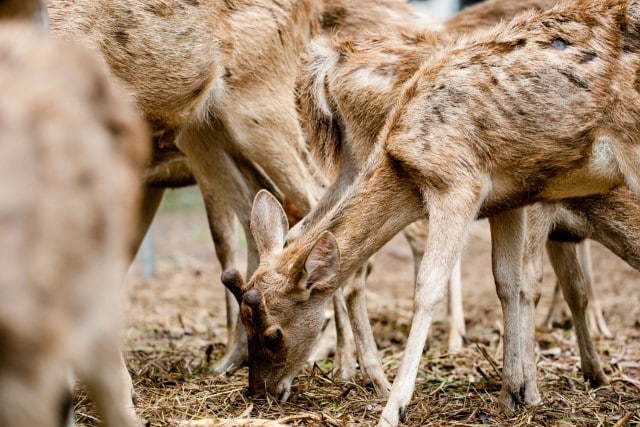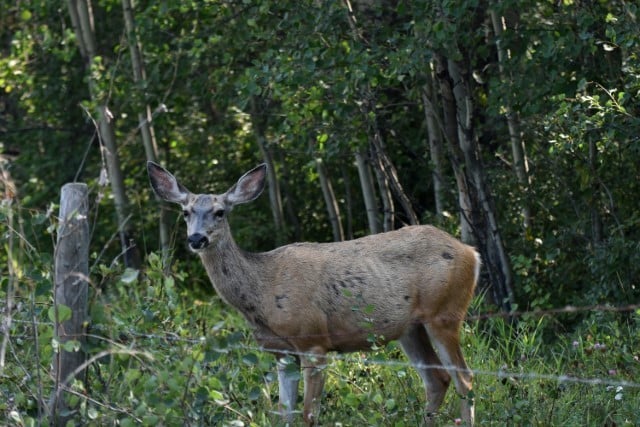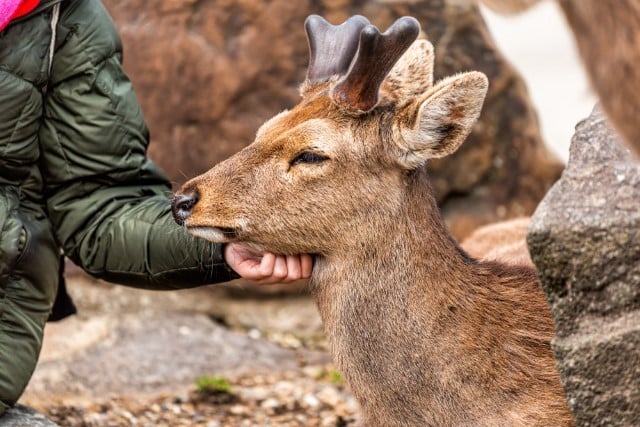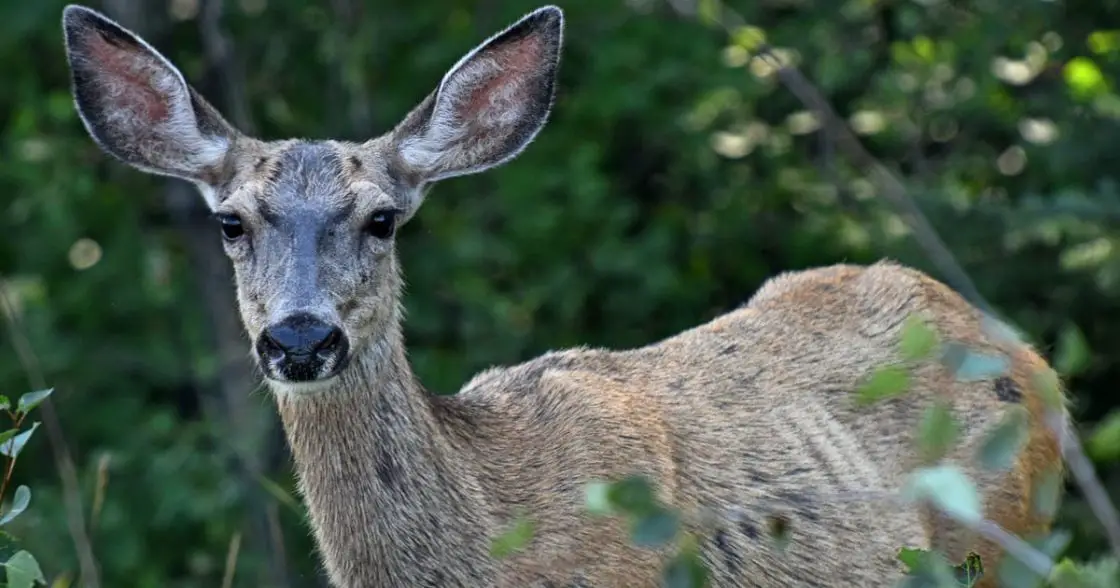Whether you’re a wildlife biologist, hunter, or simply concerned about the deer bedding down in your backyard, you should know about the diseases that cervids sometimes carry. Keep reading to find a comprehensive list of deer diseases.
You’ve got to know the signs of deer disease so you can avoid killing and eating infected animals. Some deer diseases may be transmissible to humans.
Here is the list of common deer diseases we’ll cover in this article:
- Chronic Wasting Disease (CWD)
- Bovine Tuberculosis (BTB)
- Epizootic Hemorrhagic Disease (EHD)
- Screwworm (and other kinds of parasites)
- Brain Abscesses
- Brucellosis
- Adenovirus Hemorrhagic Disease
- Cutaneous Fibromas (Deer Warts)
Below we’ll discuss each deer disease, including the symptoms, its prevalence/location, transmission information, and the typical outcomes for affected deer.
Deer Diseases
Understanding and learning to recognize the symptoms of each deer disease so you can avoid shooting deer afflicted with any of these illnesses, and inform local authorities if needed.
Chronic Wasting Disease
Chronic Wasting Disease (CWD) is sometimes called “Zombie Deer Disease.” CWD is a prion disease. This means that it’s related to transmissible spongiform encephalopathies (TSEs).
Prion diseases are neurodegenerative diseases that get worse over time.

They often have extended incubation periods. This means that it may take a long time for symptoms to begin.
Scientists believe that prions cause TSEs and CWD. A prion is an agent that is pathogenic and abnormal in nature, and it’s transmissible.
Prions that cause CWD are capable of causing certain normal cellular proteins to fold abnormally. These include the normal prion proteins in the brain that this disease attacks.
Diseases such as CWD that attack these brain cells lead to serious brain damage and death.
CWD impacts whitetail deer and other kinds of deer, such as elk, mule deer, sika deer, and reindeer, as well as moose.
There are several regions of North America where CWD has been found in deer populations. It has also been found in South Korea and Norway.
A deer infected with CWD may not have any symptoms for as long as more than a year. When CWD symptoms begin to appear, they may include neurological symptoms, listlessness, stumbling, and wasting (drastic weight loss).
CWD is a fatal condition. There are no vaccines or treatments available for this disease.
How Do Deer Catch Chronic Wasting Disease?
Current scientific knowledge holds that CWD prions or proteins probably spread through bodily fluids, including urine, blood, saliva, and feces.

Deer of every age can catch CWD. In some cases, a deer may have this disease without ever developing symptoms.
A deer may catch this disease through either indirect or direct contact with these fluids. This could happen through water, the foods deer eat, or soil contamination in their environment.
Can Humans Catch Chronic Wasting Disease?
There haven’t yet been any reports of CWD infecting people. However, there is compelling evidence from medical studies showing that it may be possible and should be considered a real hazard.
Researchers continue studies to determine the exact risk humans face of catching CWD.
Chronic Wasting Disease Symptoms
There are many potential symptoms of chronic wasting disease. These include:
- Wasting (weight loss)
- Excessive urination
- Strange behavior
- Staying away from other herd members
- Pneumonia
- Paralysis
- Poor coordination
- Intense thirst
- Excessive salivation
- Problems with swallowing
- Depression
Bovine Tuberculosis (BTB)
Mycobacterium bovis (M. bovis) is the bacterium that causes Bovine Tuberculosis (BTB). This disease is contagious among deer.
BTB is a serious and debilitating disease that lasts a long period of time. Deer are one of the animals that are impacted by this disease.

There are other kinds of animals that can be infected. For example, cattle and bison, in addition to deer species such as whitetail deer, elk, and moose, are animals in Canada that may be affected by BTB.
It’s possible for bovine tuberculosis to infect humans. It’s much rarer for that to happen than for a human to contract M. tuberculosis, which is a human-adapted bacteria.
Deer may catch Bovine Tuberculosis through close contact with an animal that already has the disease. One of the challenges of Bovine Tuberculosis is how difficult it can be to recognize and diagnose.
BTB in deer is not only a concern to hunters but also farmers in an affected area. After all, this is a bovine disease that can infect cattle.
Epizootic Hemorrhagic Disease (EHD)
EHD is a viral disease that may infect whitetail deer. This illness causes serious internal bleeding and it’s frequently fatal.
The presence of this disease in white tailed deer populations stretches back decades in the United States. There have been thousands of deer in the mule deer and whitetail deer, and also in the pronghorn antelope species that have had fatal EHD.

One EHD outbreak you may have heard about occurred in Michigan in 2012. Approximately 15,000 deer died as a result.
Deer catch Epizootic Hemorrhagic Disease (EHD) through contact with an infected deer and through other means, such as being bitten by a midge. Culicoides midges are well-known to carry the Epizootic Hemorrhagic Disease (EHD) virus.
Symptoms of Epizootic Hemorrhagic Disease
Epizootic Hemorrhagic Disease (EHD) symptoms tend to appear relatively quickly, sometimes as soon as fewer than seven days after infection. Symptoms of EHD include:
- Head or neck swelling
- Appearance of unhealthiness
- Blue tongue caused by hemorrhaging and low blood oxygen
- Fever and signs of fever, such as deer entering bodies of water to cool down
- Faster than normal respiration and pulse rate
- Excessive salivation
- Weakness
- Lack of fear of humans
- Poor appetite
If an area has a cluster of deer found with this disease and there is an individual animal with some of these symptoms, it’s even more likely that it has EHD.
When Do EHD Outbreaks Occur?
There are certain times of the year when EHD outbreaks are more likely to happen. The later parts of the summer and the early fall are when EHD outbreaks most often happen.
Scientists believe that this is because midges infected with the virus are sent over longer distances by powerful winds.
It’s believed that climate change will make EHD a bigger problem, as the summer becomes warmer and longer. That is because there will be a larger number of midges from a longer breeding season.
Extended hot weather may also make this disease spread more overall. There are no vaccines or treatments currently available for EHD.
Does EHD Affect Humans?
Experts generally advise that deer meat should be safe to eat as long as the animal hasn’t shown any symptoms of EHD. As always, you must properly field dress your deer.
This seems to be true even if an animal is infected with the disease but isn’t showing symptoms. If a deer is showing symptoms of this or any other kind of disease, you shouldn’t eat the meat.
Screwworm and Other Kinds of Parasite
Screwworm (New World Screwworm) is a species of fly larvae and parasite. It feeds on the flesh of living warm-blooded animals.

Until November 2016, wildlife authorities had seen the presence of this parasite slow down significantly. However, it has since made a comeback in certain regions, such as the Florida Keys.
Screwworm may devastate an area’s deer population if it becomes prevalent. In 2017, screwworm killed at least 130 individuals of an endangered deer species.
The screwworm is a fly. That means it can easily travel distances to infect animals. Female screwworms sometimes lay eggs in the navals of female deer. This may result in an infection.
Screwworm flies often lay eggs in a deer’s open wounds.
Of course, it’s not just deer that screwworm targets. They will infect many different kinds of animals, including commercial livestock.
A single screwworm fly is quite large, usually around double an average housefly. A female is able to lay as many as 400 eggs in one sitting.
It only takes about 12 hours for the larvae to hatch.
When screwworm larvae find themselves within a host animal, they will grow much bigger. In fact, they will probably be about half an inch within one week, or even five days.
If proper treatment isn’t provided, the animal will end up with an enormous and serious maggot infestation that can lead to death. In fact, a cow may die within seven days from a screwworm infestation.
Deer and Parasites
It’s normal for a white-tailed deer to have many different parasites. While many of them don’t cause illness, some of them do.
Deer are hardy animals, and they’re able to tolerate many types of parasites.
When a deer has a parasite that it cannot tolerate and that causes illness, this may lead to a dangerous situation.
Deer are more prone to ending up with parasite problems if they aren’t getting adequate nutrition of the right kinds. Poor and degraded habitat puts deer at risk of problematic parasite infestations.
Brain Abscesses
White-tailed deer sometimes form dangerous brain abscesses. These are closed quantities of pus that accumulate in the brain.

Arcanobacterium pyogenes (A. pyogenes) is the bacteria that most commonly causes deer brain abscesses. Unfortunately, deer gums and skin often carries this bacteria. It can cause a brain abscess if it enters the animal’s bloodstream through a wound.
Some of the most common scenarios in which this bacteria gets into the bloodstream and is able to cause brain abscesses is if a buck breaks an antler.
Injuries to the pedicle (the antler base) and to the antler velvet before it sheds can make it easier for the A. pyogenes bacteria to get into the body and cause abscesses.
Symptoms of Brain Abscesses
Some of the symptoms of brain abscesses in deer include:
- Swollen joints
- Broken antlers
- Swollen eyes
- Lameness
- Pus in the pedicles and/or eye sockets
How Prevalent Are Brain Abscesses in Deer?
Bucks in the white-tailed species are most prone to developing these brain abscesses. Overall, brain abscesses are relatively rare.
Brain abscesses don’t always result in death. The bacteria that causes brain abscesses in deer may also cause the same problem in other areas of the body.
Scientists have detected deer with brain abscesses all over North America, in most places where white-tailed deer exist.
Deer with brain abscesses have been found in these states:
- Wyoming
- Florida
- Virginia
- Georgia
- Kentucky
- Idaho
- Pennsylvania
- New York
- New Jersey
- North Carolina
- Missouri
- Minnesota
- Michigan
- West Virginia
- Missouri
- South Carolina
They have also been identified in several Canadian provinces:
- Saskatchewan
- Ontario
- British Columbia
- Alberta
Brucellosis
Brucellosis is a common deer disease. Several different kinds of the Brucella bacterium cause Brucellosis. This is a contagious disease, and it’s chronic in nature and progression.

Deer are only one species that Brucellosis affects. Other animals that may contract this disease include horses, sheep, goats, bison, cattle, and other kinds of ruminants.
Brucellosis is a zoonotic disease that may be contracted by humans. There are several different kinds of brucellosis. The one that mainly impacts white-tailed deer is bovine brucellosis.
Bovine brucellosis also affects elk, bison, and cattle.
Humans may contract bovine brucellosis as well as the other types of brucellosis.
Brucellosis impacts deer populations in many places all over the world.
There are several different ways that deer can contract brucellosis. These include:
- Eating food or drinking water contaminated with fluids or tissues infected with brucellosis
- Drinking milk or colostrum from an animal infected with brucellosis
- Coming in direct contact with an infected animal’s fluids or tissues
Brucellosis Symptoms
After a deer is infected with brucellosis, the bacteria will make its way through the bloodstream and the lymphatic system.
The brucellosis bacteria will infect the animal’s tissues, especially in the joins, mammary glands, and reproductive organs. This may lead to infertility in females, as well as weak offspring and failed pregnancies.
Spontaneous abortions are the most common sign of brucellosis in female deer. It’s possible that the same female will be able to bring any subsequent pregnancies to full term.
However, her young will still consume the bacteria in her milk.
When it comes to male deer, brucellosis often leads to infections of the testicles. This leads to lower fertility.
Other symptoms of brucellosis may include lameness, enlarged joints, and joint infections. Infection of the knee joint is common.
Can Humans Contract Brucellosis?
It’s possible for humans to contract brucellosis from deer. When this happened, it was referred to as “undulant fever.”
This is rare, however, as hunters understand how to use proper hygiene and field dressing with their prey.
Adenovirus Hemorrhagic Disease in Deer
The virus that causes Adenovirus Hemorrhagic Disease in deer is part of a small virus group called the adenoviruses. Adenoviruses affect animals, both domestic and wild.
Scientists have known about the adenovirus that causes disease in deer since 1994.
What are the Symptoms of Adenovirus Hemorrhagic Disease in Deer?
This disease is often signaled in deer by the presence of illnesses such as pneumonia and bluetongue. There are also chronic symptoms that may appear, such as abscesses and ulcers in the throat and mouth.
Examples of acute symptoms are breathing with an open mouth and/or rapidly, drooling and foaming at the mouth, weakness, and diarrhea.
A deer may die as quickly as three to five days from when they first catch the virus. Young fawns are much more susceptible to dying from Adenovirus Hemorrhagic Disease.
Adults often survive this disease.
How is Adenovirus Hemorrhagic Disease Transmitted?
Deer catch this virus through direct contact with the bodily fluids of infected animals. Scientists believe airborne transmission may also be possible.
Deer will usually show symptoms of the disease within one week.
Cutaneous Fibromas (Deer Warts)
Cutaneous fibromas, otherwise known as deer warts, is one of the deer diseases with the most obvious symptoms.
When a deer has a severe case of deer warts, it’s not something you can easily miss. In some cases, most of the deer’s body will be covered with large, dark-colored warts.
Deer warts are caused by a virus that the animal catches through contact with an infected deer. Male deer are more prone to getting deer warts because of how they fight using their antlers.
Also, male deer often rub their antlers on trees where other deer have rubbed before.
Certain biting insects can also transmit this virus. In most cases, deer warts won’t end up being fatal to the animal.
However, it’s possible that it can eventually blind the deer and incapacitate it. This may lead to starvation and death.
How Can Deer Diseases Affect Humans?
Certain deer diseases can negatively affect humans, and they may even lead to serious and dangerous illness.
In some cases, deer diseases may be present in an animal without many noticeable symptoms yet cause dangerous disease for a human being who contracts it.
When a human catches a disease from an animal, it’s called a zoonotic disease. If you have a compromised immune system or are pregnant, you may be more likely to catch a zoonotic disease.
Learn to Recognize Disease in Deer
Understanding and being able to recognize diseases in deer is an essential skill for hunters.

Keep yourself and everyone eating your deer meat safe through correct hygiene and field dressing, and by avoiding diseased animals. If a deer looks sick or unwell in some way, avoid it.
Final Thoughts on Deer Diseases
As a deer hunter, you must understand cervid diseases so that you can avoid killing diseased deer (and eating their meat).
As we’ve learned here, some deer diseases may infect humans while others do not. You should never eat the meat from a deer with symptoms of illness, whether or not you know what that illness is.
Proper field-dressing is essential for making the venison from healthy deer safe to eat. However, this won’t make the meat safe if it comes from a deer with symptoms of a disease.


